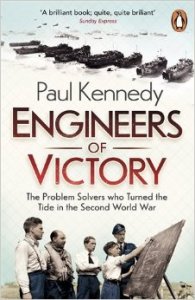Engineers of Victory: The problem solvers who turned the tide in the Second World War by Paul Kennedy
Paul Kennedy’s magisterial study of the Second World War identifies five challenges that were key to the Allies winning the war – finding a way to get convoys safely across the Atlantic, winning command of the air, stopping blitzkrieg tactics, working out how to seize an enemy-held shore and overcoming the ‘tyranny of distance’ (operating far away from the military’s home bases). He charts the many failures along the way in overcoming those five challenges, and focuses in on how they were beaten, making this a history of the evolution of technologies and tactics rather than an account of one battle after another.
 This approaches makes the eventual Allied victory look less certain than in classic accounts, especially as Kennedy takes the reader through the formidable difficulties in turning economic dominance into actual military superiority, and also makes the outcome of the war look much more uncertain from the perspective of early 1943 than is usually given credit for with the traditional identification of turning points at Stalingrad, El Alamein and Midway.
This approaches makes the eventual Allied victory look less certain than in classic accounts, especially as Kennedy takes the reader through the formidable difficulties in turning economic dominance into actual military superiority, and also makes the outcome of the war look much more uncertain from the perspective of early 1943 than is usually given credit for with the traditional identification of turning points at Stalingrad, El Alamein and Midway.
Kennedy’s account also makes those who opposed invading France until 1944 seem very wise; the long trail of mistakes made at Dieppe, Kasserine Pass, Salerno, Anzio and elsewhere were vital learning stages. It’s hard to read the book and not conclude that American enthusiasm for an invasion of France in 1943 would have led to disaster.
The use of “engineers” in the title is perhaps a little problematic, as judging by other online reviews it led some readers to expect detailed engineering stories. That’s not what Kennedy provides: he explains the strategic context which made certain problems so important for engineers to fix, and hence also why the work of some engineers was so much more important than that of others.
Hence Paul Kennedy gives very little detail about, for example, the Mulberry artificial harbours that were so important to making the days after D-Day a success. But his broader account of the logistical problems armies faced as they moved further and further from their original bases explains why they were so important.
In other words, it’s in explaining why some problems were so vital to fix that Kennedy’s book stands out. His descriptions of exactly how they were fixed are more variable in level of detail (and, judging by other apparently well-informed reviews, in accuracy of details too).
This approach means too that some famous problem solvers get very little credit in the book as they were not working on problems Kennedy has identified as the big ones of the war.
Most notably and controversially, the codebreakers therefore get little credit. He addresses this briefly, arguing that whilst the intelligence they produced was useful, when you get down to looking at the individual struggles, it is hard to assign improved intelligence as the key to their course. For example, in the battle with U-boats in the North Atlantic, intelligence was useful – but it was developments in a wide range of technologies and tactics that can be more closely traced with the changing fortunes on that battlefield.
The book comes with a good number of photographs, though disappointingly small in size. One however, despite its size, did have a powerful impact on me. It’s of the Gilbert Islands, apparently showing a scene of devastation from after the American invasion. But check the date, and the photo was actually taken four years afterward – a powerful testament to how massive and long-lasting the destruction caused by a world war is.
Got a view on this review? Then please rate it on Amazon.
Leave a Reply